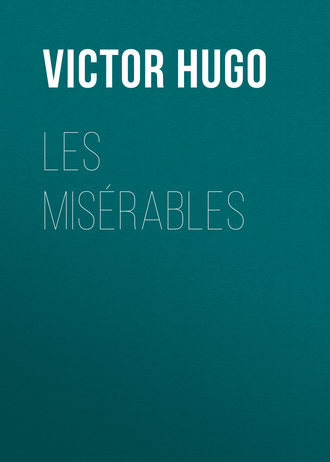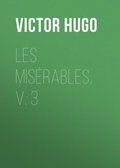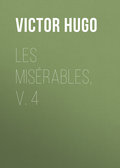
Виктор Мари Гюго
Les Misérables
CHAPTER II – HOUGOMONT
Hougomont, – this was a funereal spot, the beginning of the obstacle, the first resistance, which that great wood-cutter of Europe, called Napoleon, encountered at Waterloo, the first knot under the blows of his axe.
It was a château; it is no longer anything but a farm. For the antiquary, Hougomont is Hugomons. This manor was built by Hugo, Sire of Somerel, the same who endowed the sixth chaplaincy of the Abbey of Villiers.
The traveller pushed open the door, elbowed an ancient calash under the porch, and entered the courtyard.
The first thing which struck him in this paddock was a door of the sixteenth century, which here simulates an arcade, everything else having fallen prostrate around it. A monumental aspect often has its birth in ruin. In a wall near the arcade opens another arched door, of the time of Henry IV., permitting a glimpse of the trees of an orchard; beside this door, a manure-hole, some pickaxes, some shovels, some carts, an old well, with its flagstone and its iron reel, a chicken jumping, and a turkey spreading its tail, a chapel surmounted by a small bell-tower, a blossoming pear-tree trained in espalier against the wall of the chapel – behold the court, the conquest of which was one of Napoleon’s dreams. This corner of earth, could he but have seized it, would, perhaps, have given him the world likewise. Chickens are scattering its dust abroad with their beaks. A growl is audible; it is a huge dog, who shows his teeth and replaces the English.
The English behaved admirably there. Cooke’s four companies of guards there held out for seven hours against the fury of an army.
Hougomont viewed on the map, as a geometrical plan, comprising buildings and enclosures, presents a sort of irregular rectangle, one angle of which is nicked out. It is this angle which contains the southern door, guarded by this wall, which commands it only a gun’s length away. Hougomont has two doors, – the southern door, that of the château; and the northern door, belonging to the farm. Napoleon sent his brother Jérôme against Hougomont; the divisions of Foy, Guilleminot, and Bachelu hurled themselves against it; nearly the entire corps of Reille was employed against it, and miscarried; Kellermann’s balls were exhausted on this heroic section of wall. Bauduin’s brigade was not strong enough to force Hougomont on the north, and the brigade of Soye could not do more than effect the beginning of a breach on the south, but without taking it.
The farm buildings border the courtyard on the south. A bit of the north door, broken by the French, hangs suspended to the wall. It consists of four planks nailed to two cross-beams, on which the scars of the attack are visible.
The northern door, which was beaten in by the French, and which has had a piece applied to it to replace the panel suspended on the wall, stands half-open at the bottom of the paddock; it is cut squarely in the wall, built of stone below, of brick above which closes in the courtyard on the north. It is a simple door for carts, such as exist in all farms, with the two large leaves made of rustic planks: beyond lie the meadows. The dispute over this entrance was furious. For a long time, all sorts of imprints of bloody hands were visible on the door-posts. It was there that Bauduin was killed.
The storm of the combat still lingers in this courtyard; its horror is visible there; the confusion of the fray was petrified there; it lives and it dies there; it was only yesterday. The walls are in the death agony, the stones fall; the breaches cry aloud; the holes are wounds; the drooping, quivering trees seem to be making an effort to flee.
This courtyard was more built up in 1815 than it is to-day. Buildings which have since been pulled down then formed redans and angles.
The English barricaded themselves there; the French made their way in, but could not stand their ground. Beside the chapel, one wing of the château, the only ruin now remaining of the manor of Hougomont, rises in a crumbling state, – disembowelled, one might say. The château served for a dungeon, the chapel for a block-house. There men exterminated each other. The French, fired on from every point, – from behind the walls, from the summits of the garrets, from the depths of the cellars, through all the casements, through all the air-holes, through every crack in the stones, – fetched fagots and set fire to walls and men; the reply to the grape-shot was a conflagration.
In the ruined wing, through windows garnished with bars of iron, the dismantled chambers of the main building of brick are visible; the English guards were in ambush in these rooms; the spiral of the staircase, cracked from the ground floor to the very roof, appears like the inside of a broken shell. The staircase has two stories; the English, besieged on the staircase, and massed on its upper steps, had cut off the lower steps. These consisted of large slabs of blue stone, which form a heap among the nettles. Half a score of steps still cling to the wall; on the first is cut the figure of a trident. These inaccessible steps are solid in their niches. All the rest resembles a jaw which has been denuded of its teeth. There are two old trees there: one is dead; the other is wounded at its base, and is clothed with verdure in April. Since 1815 it has taken to growing through the staircase.
A massacre took place in the chapel. The interior, which has recovered its calm, is singular. The mass has not been said there since the carnage. Nevertheless, the altar has been left there – an altar of unpolished wood, placed against a background of roughhewn stone. Four whitewashed walls, a door opposite the altar, two small arched windows; over the door a large wooden crucifix, below the crucifix a square air-hole stopped up with a bundle of hay; on the ground, in one corner, an old window-frame with the glass all broken to pieces – such is the chapel. Near the altar there is nailed up a wooden statue of Saint Anne, of the fifteenth century; the head of the infant Jesus has been carried off by a large ball. The French, who were masters of the chapel for a moment, and were then dislodged, set fire to it. The flames filled this building; it was a perfect furnace; the door was burned, the floor was burned, the wooden Christ was not burned. The fire preyed upon his feet, of which only the blackened stumps are now to be seen; then it stopped, – a miracle, according to the assertion of the people of the neighborhood. The infant Jesus, decapitated, was less fortunate than the Christ.
The walls are covered with inscriptions. Near the feet of Christ this name is to be read: Henquinez. Then these others: Conde de Rio Maior Marques y Marquesa de Almagro (Habana). There are French names with exclamation points, – a sign of wrath. The wall was freshly whitewashed in 1849. The nations insulted each other there.
It was at the door of this chapel that the corpse was picked up which held an axe in its hand; this corpse was Sub-Lieutenant Legros.
On emerging from the chapel, a well is visible on the left. There are two in this courtyard. One inquires, Why is there no bucket and pulley to this? It is because water is no longer drawn there. Why is water not drawn there? Because it is full of skeletons.
The last person who drew water from the well was named Guillaume van Kylsom. He was a peasant who lived at Hougomont, and was gardener there. On the 18th of June, 1815, his family fled and concealed themselves in the woods.
The forest surrounding the Abbey of Villiers sheltered these unfortunate people who had been scattered abroad, for many days and nights. There are at this day certain traces recognizable, such as old boles of burned trees, which mark the site of these poor bivouacs trembling in the depths of the thickets.
Guillaume van Kylsom remained at Hougomont, “to guard the château,” and concealed himself in the cellar. The English discovered him there. They tore him from his hiding-place, and the combatants forced this frightened man to serve them, by administering blows with the flats of their swords. They were thirsty; this Guillaume brought them water. It was from this well that he drew it. Many drank there their last draught. This well where drank so many of the dead was destined to die itself.
After the engagement, they were in haste to bury the dead bodies. Death has a fashion of harassing victory, and she causes the pest to follow glory. The typhus is a concomitant of triumph. This well was deep, and it was turned into a sepulchre. Three hundred dead bodies were cast into it. With too much haste perhaps. Were they all dead? Legend says they were not. It seems that on the night succeeding the interment, feeble voices were heard calling from the well.
This well is isolated in the middle of the courtyard. Three walls, part stone, part brick, and simulating a small, square tower, and folded like the leaves of a screen, surround it on all sides. The fourth side is open. It is there that the water was drawn. The wall at the bottom has a sort of shapeless loophole, possibly the hole made by a shell. This little tower had a platform, of which only the beams remain. The iron supports of the well on the right form a cross. On leaning over, the eye is lost in a deep cylinder of brick which is filled with a heaped-up mass of shadows. The base of the walls all about the well is concealed in a growth of nettles.
This well has not in front of it that large blue slab which forms the table for all wells in Belgium. The slab has here been replaced by a cross-beam, against which lean five or six shapeless fragments of knotty and petrified wood which resemble huge bones. There is no longer either pail, chain, or pulley; but there is still the stone basin which served the overflow. The rain-water collects there, and from time to time a bird of the neighboring forests comes thither to drink, and then flies away. One house in this ruin, the farmhouse, is still inhabited. The door of this house opens on the courtyard. Upon this door, beside a pretty Gothic lock-plate, there is an iron handle with trefoils placed slanting. At the moment when the Hanoverian lieutenant, Wilda, grasped this handle in order to take refuge in the farm, a French sapper hewed off his hand with an axe.
The family who occupy the house had for their grandfather Guillaume van Kylsom, the old gardener, dead long since. A woman with gray hair said to us: “I was there. I was three years old. My sister, who was older, was terrified and wept. They carried us off to the woods. I went there in my mother’s arms. We glued our ears to the earth to hear. I imitated the cannon, and went boum! boum!”
A door opening from the courtyard on the left led into the orchard, so we were told. The orchard is terrible.
It is in three parts; one might almost say, in three acts. The first part is a garden, the second is an orchard, the third is a wood. These three parts have a common enclosure: on the side of the entrance, the buildings of the château and the farm; on the left, a hedge; on the right, a wall; and at the end, a wall. The wall on the right is of brick, the wall at the bottom is of stone. One enters the garden first. It slopes downwards, is planted with gooseberry bushes, choked with a wild growth of vegetation, and terminated by a monumental terrace of cut stone, with balustrade with a double curve.
It was a seignorial garden in the first French style which preceded Le Nôtre; to-day it is ruins and briars. The pilasters are surmounted by globes which resemble cannon-balls of stone. Forty-three balusters can still be counted on their sockets; the rest lie prostrate in the grass. Almost all bear scratches of bullets. One broken baluster is placed on the pediment like a fractured leg.
It was in this garden, further down than the orchard, that six light-infantry men of the 1st, having made their way thither, and being unable to escape, hunted down and caught like bears in their dens, accepted the combat with two Hanoverian companies, one of which was armed with carbines. The Hanoverians lined this balustrade and fired from above. The infantry men, replying from below, six against two hundred, intrepid and with no shelter save the currant-bushes, took a quarter of an hour to die.
One mounts a few steps and passes from the garden into the orchard, properly speaking. There, within the limits of those few square fathoms, fifteen hundred men fell in less than an hour. The wall seems ready to renew the combat. Thirty-eight loopholes, pierced by the English at irregular heights, are there still. In front of the sixth are placed two English tombs of granite. There are loopholes only in the south wall, as the principal attack came from that quarter. The wall is hidden on the outside by a tall hedge; the French came up, thinking that they had to deal only with a hedge, crossed it, and found the wall both an obstacle and an ambuscade, with the English guards behind it, the thirty-eight loopholes firing at once a shower of grape-shot and balls, and Soye’s brigade was broken against it. Thus Waterloo began.
Nevertheless, the orchard was taken. As they had no ladders, the French scaled it with their nails. They fought hand to hand amid the trees. All this grass has been soaked in blood. A battalion of Nassau, seven hundred strong, was overwhelmed there. The outside of the wall, against which Kellermann’s two batteries were trained, is gnawed by grape-shot.
This orchard is sentient, like others, in the month of May. It has its buttercups and its daisies; the grass is tall there; the cart-horses browse there; cords of hair, on which linen is drying, traverse the spaces between the trees and force the passer-by to bend his head; one walks over this uncultivated land, and one’s foot dives into mole-holes. In the middle of the grass one observes an uprooted tree-bole which lies there all verdant. Major Blackmann leaned against it to die. Beneath a great tree in the neighborhood fell the German general, Duplat, descended from a French family which fled on the revocation of the Edict of Nantes. An aged and falling apple-tree leans far over to one side, its wound dressed with a bandage of straw and of clayey loam. Nearly all the apple-trees are falling with age. There is not one which has not had its bullet or its biscayan.6 The skeletons of dead trees abound in this orchard. Crows fly through their branches, and at the end of it is a wood full of violets.
Bauduin killed, Foy wounded, conflagration, massacre, carnage, a rivulet formed of English blood, French blood, German blood mingled in fury, a well crammed with corpses, the regiment of Nassau and the regiment of Brunswick destroyed, Duplat killed, Blackmann killed, the English Guards mutilated, twenty French battalions, besides the forty from Reille’s corps, decimated, three thousand men in that hovel of Hougomont alone cut down, slashed to pieces, shot, burned, with their throats cut, – and all this so that a peasant can say to-day to the traveller: Monsieur, give me three francs, and if you like, I will explain to you the affair of Waterloo!
CHAPTER III – THE EIGHTEENTH OF JUNE, 1815
Let us turn back, – that is one of the story-teller’s rights, – and put ourselves once more in the year 1815, and even a little earlier than the epoch when the action narrated in the first part of this book took place.
If it had not rained in the night between the 17th and the 18th of June, 1815, the fate of Europe would have been different. A few drops of water, more or less, decided the downfall of Napoleon. All that Providence required in order to make Waterloo the end of Austerlitz was a little more rain, and a cloud traversing the sky out of season sufficed to make a world crumble.
The battle of Waterloo could not be begun until half-past eleven o’clock, and that gave Blücher time to come up. Why? Because the ground was wet. The artillery had to wait until it became a little firmer before they could manœuvre.
Napoleon was an artillery officer, and felt the effects of this. The foundation of this wonderful captain was the man who, in the report to the Directory on Aboukir, said: Such a one of our balls killed six men. All his plans of battle were arranged for projectiles. The key to his victory was to make the artillery converge on one point. He treated the strategy of the hostile general like a citadel, and made a breach in it. He overwhelmed the weak point with grape-shot; he joined and dissolved battles with cannon. There was something of the sharpshooter in his genius. To beat in squares, to pulverize regiments, to break lines, to crush and disperse masses, – for him everything lay in this, to strike, strike, strike incessantly, – and he intrusted this task to the cannon-ball. A redoubtable method, and one which, united with genius, rendered this gloomy athlete of the pugilism of war invincible for the space of fifteen years.
On the 18th of June, 1815, he relied all the more on his artillery, because he had numbers on his side. Wellington had only one hundred and fifty-nine mouths of fire; Napoleon had two hundred and forty.
Suppose the soil dry, and the artillery capable of moving, the action would have begun at six o’clock in the morning. The battle would have been won and ended at two o’clock, three hours before the change of fortune in favor of the Prussians. What amount of blame attaches to Napoleon for the loss of this battle? Is the shipwreck due to the pilot?
Was it the evident physical decline of Napoleon that complicated this epoch by an inward diminution of force? Had the twenty years of war worn out the blade as it had worn the scabbard, the soul as well as the body? Did the veteran make himself disastrously felt in the leader? In a word, was this genius, as many historians of note have thought, suffering from an eclipse? Did he go into a frenzy in order to disguise his weakened powers from himself? Did he begin to waver under the delusion of a breath of adventure? Had he become – a grave matter in a general – unconscious of peril? Is there an age, in this class of material great men, who may be called the giants of action, when genius grows short-sighted? Old age has no hold on the geniuses of the ideal; for the Dantes and Michael Angelos to grow old is to grow in greatness; is it to grow less for the Hannibals and the Bonapartes? Had Napoleon lost the direct sense of victory? Had he reached the point where he could no longer recognize the reef, could no longer divine the snare, no longer discern the crumbling brink of abysses? Had he lost his power of scenting out catastrophes? He who had in former days known all the roads to triumph, and who, from the summit of his chariot of lightning, pointed them out with a sovereign finger, had he now reached that state of sinister amazement when he could lead his tumultuous legions harnessed to it, to the precipice? Was he seized at the age of forty-six with a supreme madness? Was that titanic charioteer of destiny no longer anything more than an immense dare-devil?
We do not think so.
His plan of battle was, by the confession of all, a masterpiece. To go straight to the centre of the Allies’ line, to make a breach in the enemy, to cut them in two, to drive the British half back on Hal, and the Prussian half on Tongres, to make two shattered fragments of Wellington and Blücher, to carry Mont-Saint-Jean, to seize Brussels, to hurl the German into the Rhine, and the Englishman into the sea. All this was contained in that battle, according to Napoleon. Afterwards people would see.
Of course, we do not here pretend to furnish a history of the battle of Waterloo; one of the scenes of the foundation of the story which we are relating is connected with this battle, but this history is not our subject; this history, moreover, has been finished, and finished in a masterly manner, from one point of view by Napoleon, and from another point of view by a whole pleiad of historians.7
As for us, we leave the historians at loggerheads; we are but a distant witness, a passer-by on the plain, a seeker bending over that soil all made of human flesh, taking appearances for realities, perchance; we have no right to oppose, in the name of science, a collection of facts which contain illusions, no doubt; we possess neither military practice nor strategic ability which authorize a system; in our opinion, a chain of accidents dominated the two leaders at Waterloo; and when it becomes a question of destiny, that mysterious culprit, we judge like that ingenious judge, the populace.







